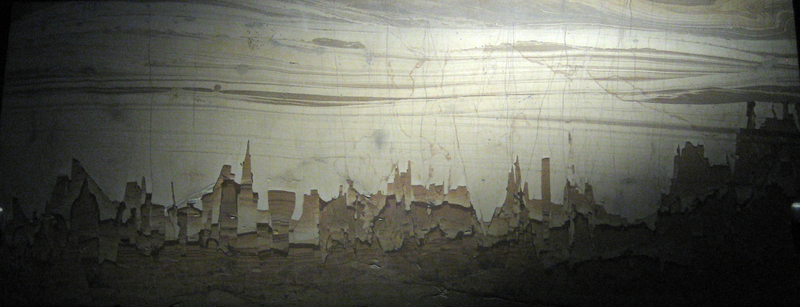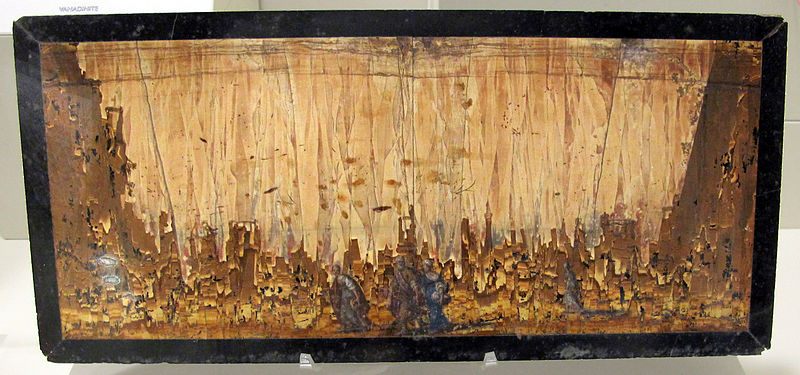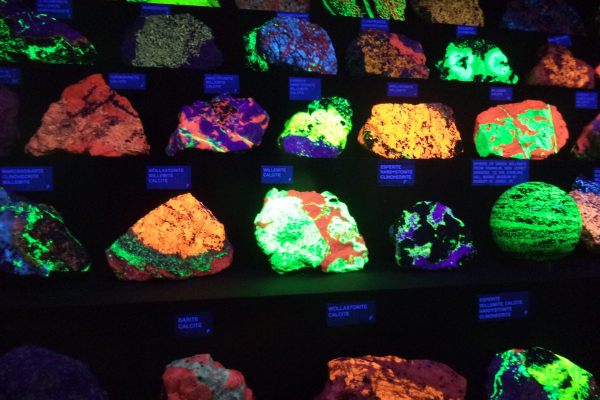The Rare Stone Whose Markings Resemble City Skylines
“Ruin marble” contains tiny worlds.

Geology made this bleak cityscape. (Photo: Mirtio/Public Domain)
Hiding deep within the Earth are the ruins of dead cities, complete with crumbling skylines and apocalyptic vistas. Or at least that’s what it looks like. So-called “ruin marble,” is made up of stunning slices of polished stone that have randomly produced what appears to be silhouettes of human-made ruins and blasted landscapes. But it’s all just the result of a specific regional geology.
Also known as ruiniform marble, landscape stone, and Pietra Paesina, ruin marble is mainly found around the city of Florence in Tuscany. It has been found in places outside of Italy, such as Austria, but the geological conditions needed to create the unique forms are rare.

Castles in the stone. (Photo: Gpierlu/CC BY-SA 3.0)
Ruin marble is not actually marble, but a conglomeration of limestone and other minerals, mainly iron oxides, that co-mingle to form shapes that seem uncannily geometric. Most ruin marble was likely formed around 50 million years ago, as groundwater seeped up through still-forming minerals mixing and aligning the stones into their miniature city-like formations.
A more technical description comes from a 1953 entry in the American Journal of Science: “Ruin-marble is a kind of compact calcareous marl, showing when polished, pictures of fortifications, temples, etc. in ruins due to infiltration of oxide of iron.”
In addition to the patterns created by liquids, small fossils and algae can often get caught up in the stone, creating more natural, but nonetheless eye-catching shapes. Unlike the sharper, more architectural forms, these natural imperfections can create the feel of foliage, or smoke. These wrinkles give the little worlds even more texture.

Green skies over broken steeples. (Photo: Michel-georges bernard/CC BY-SA 3.0)
Color-wise, ruin marble tends to run the gamut from bleak grays and blacks, like the piece held in the London Museum of Natural History. It can also take on hues of brighter oranges and reds as the iron and limestone come together.
Ruin marble is very rare because it is not something that can be identified from the surface. Outside of focusing on the areas around Florence where it is known to occur, finding the perfect piece of limestone sediment is just luck. It is not impossible to shine much of the stone from the area into a lovely little landscape (see the video here to watch the process in action), but finding a section that looks just like a city skyline is no easy feat.
The finished polished stones tend to be fairly small. Due to the size of the undulations in the stone, and the amount that gets taken off in the polishing process, finished pieces of ruin marble can usually fit in the palm of your hand.

A city on fire. (Photo: Sailko/CC BY 3.0)
Ruin marble has been sought after for centuries as a decorative piece of art. Renaissance furniture makers were known to incorporate pieces of the stone into their creations, while others put them on display as curiosities of their own. Some people would even paint other images on the polished rocks to alter or accent the natural patterns. Many of these pieces have ended up in museums, which is still the best place to catch a glimpse of these ruined limestone landscapes.






















Follow us on Twitter to get the latest on the world's hidden wonders.
Like us on Facebook to get the latest on the world's hidden wonders.
Follow us on Twitter Like us on Facebook